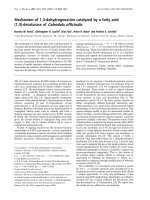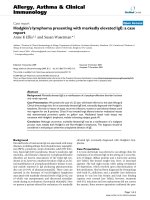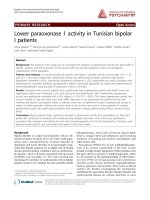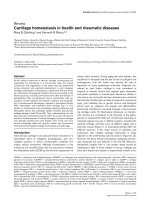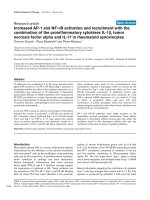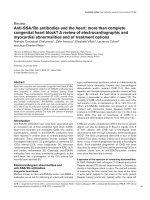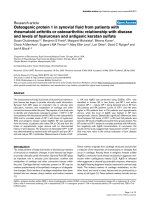Báo cáo y học: "Statistics review 1: Presenting and summarising data" pptx
Bạn đang xem bản rút gọn của tài liệu. Xem và tải ngay bản đầy đủ của tài liệu tại đây (57.37 KB, 6 trang )
Critical Care February 2002 Vol 6 No 1 Whitley and Ball
Data description is a vital part of any research project and
should not be ignored in the rush to start testing hypothe-
ses. There are many reasons for this important process,
such as gaining familiarity with the data, looking for unusu-
ally high or low values (outliers) and checking the assump-
tions required for statistical testing. The two most
common types of data are qualitative and quantitative
(Fig. 1). Qualitative data fall into two categories:
unordered qualitative data, such as ventilatory support
(none, non-invasive, intermittent positive-pressure ventila-
tion, oscillatory); and ordered qualitative data, such as
severity of disease (mild, moderate, severe). Quantitative
data are numerical and fall into two categories: discrete
quantitative data, such as the number of days spent in
intensive care; and continuous quantitative data, such as
blood pressure or haemoglobin concentrations. Tables are
a useful way of describing both qualitative and grouped
quantitative data and there are also many types of graph
that provide a convenient summary. Qualitative data are
commonly described using bar or pie charts, whereas
quantitative data can be represented using histograms or
box and whisker plots.
Tables and graphs provide a convenient simple picture of a
set of data (dataset), but it is often necessary to further sum-
marize quantitative data, for example for hypothesis testing.
The two most important elements of a dataset are its location
(where on average the data lie) and its variability (the extent
to which individual data values deviate from the location).
There are several different measures of location and variability
that can be calculated, and the choice of which to use
depends on individual circumstances.
Measuring location
Mean
The mean is the most well known average value. It is calcu-
lated by summing all of the values in a dataset and dividing
them by the total number of values. The algebraic notation for
the mean of a set of n values (X
1
, X
2
, , X
n
) is:
(1)
where is the mathematical notation for the sum of all
values (X
1
, X
2
,…, X
n
). In other words:
Review
Statistics review 1: Presenting and summarising data
Elise Whitley* and Jonathan Ball
†
*Lecturer in Medical Statistics, University of Bristol, Bristol, UK
†
Lecturer in Intensive Care Medicine, St George’s Hospital Medical School, London, UK
Correspondence: Editorial Office, Critical Care,
Published online: 29 November 2001
Critical Care 2002, 6:66-71
© 2002 BioMed Central Ltd (Print ISSN 1364-8535; Online ISSN 1466-609X)
Abstract
The present review is the first in an ongoing guide to medical statistics, using specific examples from
intensive care. The first step in any analysis is to describe and summarize the data. As well as
becoming familiar with the data, this is also an opportunity to look for unusually high or low values
(outliers), to check the assumptions required for statistical tests, and to decide the best way to
categorize the data if this is necessary. In addition to tables and graphs, summary values are a
convenient way to summarize large amounts of information. This review introduces some of these
measures. It describes and gives examples of qualitative data (unordered and ordered) and quantitative
data (discrete and continuous); how these types of data can be represented figuratively; the two
important features of a quantitative dataset (location and variability); the measures of location (mean,
median and mode); the measures of variability (range, interquartile range, standard deviation and
variance); common distributions of clinical data; and simple transformations of positively skewed data.
Keywords interquartile range, mean, median, range, standard deviation, transformations, unimodal distributions
n
X
X
n
i
i
∑
=
=
1
∑
=
n
i
i
X
1
Available online />Of all the measures of location, the mean is the most com-
monly used because it is easily understood and has useful
mathematical properties that make it convenient for use in
many statistical contexts. It is strongly influenced by extreme
values (outliers), however, and is most representative when
the data are symmetrically distributed (see below).
Median
The median is the central value when all observations are
sorted in order. If there is an odd number of observations then
it is simply the middle value; if there is an even number of
observations then it is the average of the middle two. The
median does not have the beneficial mathematical properties
of the mean. However, it is not generally influenced by extreme
values (outliers), and as a result it is particularly useful in situa-
tions where there are unusually low or high values that would
render the mean unrepresentative of the data.
Mode
The mode is simply the most commonly occurring value in the
data. It is not generally used because it is often not represen-
tative of the data, particularly when the dataset is small.
Example of calculating location
To see how these quantities are calculated in practise, con-
sider the data shown in Table 1. These are haemoglobin con-
centration measurements taken from 48 patients on admission
to an intensive care unit, listed here in ascending order.
The first step in exploring these data is to construct a histo-
gram to illustrate the shape of the distribution. Rather than
plot the frequency of each value separately (e.g. one patient
with haemoglobin 5.4 g/dl, two patients with haemoglobin
6.4 g/dl, one patient with haemoglobin 7.0 g/dl, and so on),
continuous data are generally grouped or categorized before
plotting (e.g. one patient with haemoglobin between 5.0 and
5.9 g/dl, two patients with haemoglobin between 6.0 and
6.9 g/dl, four patients with haemoglobin between 7.0 and
7.9 g/dl, and so on). These categories can be defined in any
way and need not necessarily be of the same width,
although it is generally more convenient to have equally sized
groups. However, the categories must be exhaustive (the
categories must cover the full range of values in the dataset)
and exclusive (there should be no overlap between cate-
gories). Therefore, if one category ends with 6.9 g/dl then
the next must begin with 7.0 g/dl rather than 6.9 g/dl. Fig. 2
shows the data in Table 1 grouped into 1 g/dl categories
(5.0–5.9, 6.0–6.9,…, 14.0–14.9 g/dl).
Fig. 2 shows that the data are roughly symmetrically distrib-
uted; more common values are clustered around a peak in
the middle of the distribution, with decreasing numbers of
smaller and larger values on either side. The mean, median
and mode of these data are shown in Table 2.
Notice that the mean and the median are similar. This is
because the data are approximately symmetrical. In
n
n
i
i
XXXX +++=
∑
=
21
1
Figure 1
Types of data. ICU = intensive care unit.
Data
Qualitative
Quantitive
Frequency tables
Frequency tables
Bar/pie charts
Histograms/box and whisker plots
Unordered Ordered
Discrete
Continuous
Ventilatory support
Severity of illness
Days in ICU Blood pressure
Main types:
In tables, shown as:
Graphically shown as:
Types:
Examples:
Table 1
Haemoglobin (g/dl) from 48 intensive care patients
5.4 8.2 9.3 9.9 10.5 11.9
6.4 8.3 9.4 9.9 10.5 12.3
6.4 8.3 9.4 9.9 10.6 12.6
7.0 8.6 9.4 10.1 10.8 12.7
7.1 8.8 9.4 10.3 10.8 13.0
7.3 8.9 9.5 10.3 11.3 13.3
7.7 9.1 9.7 10.4 11.7 14.0
8.1 9.3 9.7 10.4 11.7 14.1
Critical Care February 2002 Vol 6 No 1 Whitley and Ball
general, the mean, median and mode will be similar in a
dataset that has a symmetrical distribution with a single
peak, such as that shown in Fig. 2. However, the dataset
presented here is rather small and so the mode is not such
a good measure of location.
Measuring variability
Range
As with location, there are a number of different measures of
variability. The simplest of these is probably the range, which
is the difference between the largest and smallest observation
in the dataset. The disadvantage of this measure is that it is
based on only two of the observations and may not be repre-
sentative of the whole dataset, particularly if there are outliers.
In addition, it gives no information regarding how the data are
distributed between the two extremes.
Interquartile range
An alternative to the range is the interquartile range. Quartiles
are calculated in a similar way to the median; the median
splits a dataset into two equally sized groups, tertiles split the
data into three (approximately) equally sized groups, quartiles
into four, quintiles into five, and so on. The interquartile range
is the range between the bottom and top quartiles, and indi-
cates where the middle 50% of the data lie. Like the median,
the interquartile range is not influenced by unusually high or
low values and may be particularly useful when data are not
symmetrically distributed. Ranges based on alternative subdi-
visions of the data can also be calculated; for example, if the
data are split into deciles, 80% of the data will lie between
the bottom and top deciles and so on.
Standard deviation
The standard deviation is a measure of the degree to which
individual observations in a dataset deviate from the mean
value. Broadly, it is the average deviation from the mean
across all observations. It is calculated by squaring the differ-
ence of each individual observation from the mean (squared
to remove any negative differences), adding them together,
dividing by the total number of observations minus 1, and
taking the square root of the result.
Algebraically the standard deviation for a set of n values (X
1
,
X
2
,…, X
n
} is written as follows:
(2)
where
and is the mean described above (Eqn 1). It can be seen
from this expression that if individual observations are all
close to the mean then the standard deviation will be small (at
the extreme, if all observations were equal to the mean then
the standard deviation would be zero). Conversely, if the
observations vary widely then the standard deviation will be
substantially larger. The standard deviation summarizes a
great deal of information in one number and, like the mean,
has useful mathematical properties.
Variance
Another measure of variability that may be encountered is the
variance. This is simply the square of the standard deviation:
(3)
The variance is not generally used in data description but is
central to analysis of variance (covered in a subsequent
review in this series).
Figure 2
Histogram of admission haemoglobin measurements from 48 intensive
care patients.
Haemoglobin (g/dl)
510
15
0
5
10
15
Frequency
Table 2
Mean, median and mode of haemoglobin measurements from
48 intensive care patients listed in Table 1
Measure Calculation
Mean The mean is the sum of the observations divided
by the number of observations, in this case
5.4 + 6.4 + + 14.1
= 9.9 g/dl
48
Median There are 48 observations in this dataset and so
the median is the average of the 24th and 25th
(i.e. the average of 9.7 and 9.9 = 9.8 g/dl)
Mode Several values appear twice in this dataset,
9.9 appears three times and 9.4 appears four
times. No value appears more than four times and
so the mode is 9.4 g/dl
)1(
)(
1
2
−
−
=
∑
=
n
XX
SD
n
i
i
22
2
2
1
1
2
)( )()()( XXXXXXXX
n
n
i
i
−++−+−=−
∑
=
X
)1(
)(
1
2
−
−
=
∑
=
n
XX
Variance
n
i
i
Example of calculating variability
Table 3 shows the calculation of the range, interquartile range
and standard deviation of the data shown in Table 1. The
range, from 5.4 to 14.1 g/dl, indicates the full extent of the
data, but does not give any information regarding how the
remaining observations are distributed between these
extremes. For example, it may be that the lower value of
5.4 g/dl is an outlier and the remainder of the observations
are all over 10.0 g/dl, or that most values lie at the lower end
of the range with substantially fewer at the other extreme. It is
impossible to tell this from the range alone.
The interquartile range (which contains the central 50% of
the data) gives a better indication of the general shape of the
distribution, and indicates that 50% of all observations fall in
a rather narrower range (from 8.7 to 10.8 g/dl). In addition,
the median and mean both fall approximately in the centre of
the interquartile range, which suggests that the distribution is
reasonably symmetrical.
The standard deviation in isolation does not provide a great
deal of information, although it is sometimes expressed as a
percentage of the mean, known as the coefficient of variation.
However, it is often used to calculate another extremely
useful quantity known as the reference range; this will be
covered in more detail in the next article.
Common distributions and simple
transformations
Quantitative clinical data follow a wide variety of distributions,
but the majority are unimodal, meaning that the data has a
single (modal) peak with a tail on either side. The most
common of these unimodal distributions are symmetrical, as
shown in Fig. 2, with a peak in the centre of the data and
evenly balanced tails on the right and left.
However, not all unimodal distributions are symmetrical; some
are skewed with a substantially longer tail on one side. The
type of skew is determined by which tail is longer. A positively
skewed distribution has a longer tail on the right; in other
words the majority of values are relatively low with a smaller
number of extreme high values. Fig. 3 shows the admission
serum urea levels of 100 intensive care patients. The majority
have a serum urea level below 20 mmol/l, with a peak
between 4.0 and 7.9 mmol/l. However, an important minority
of patients have levels above 20 mmol/l and some have levels
as high as 60 mmol/l.
The mean of these data is 12.25 mmol/l (A) and the median is
9 mmol/l (B), as indicated in Fig. 3. In a positively skewed dis-
tribution the median will always be smaller than the mean
because the mean is strongly influenced by the extreme
values in the right-hand tail, and may therefore be less repre-
sentative of the data as a whole. However, it is possible to
transform data of this type in order to obtain a more represen-
tative mean value. This type of transformation is also useful
when statistical tests require data to be more symmetrically
distributed (see subsequent reviews in this series for details).
There is a wide range of transformations that can be used in
this context [2], but the most commonly used with positively
skewed data is the logarithmic transformation.
In a logarithmic transformation, every value in the dataset is
replaced by its logarithm. Logarithms are defined to a base,
the most common being base e (natural logarithms) or base
10. The end result of a logarithmic transformation is indepen-
Available online />Table 3
Range, interquartile range and standard deviation of haemoglobin measurements from 48 intensive care patients listed in Table 1
Measure Calculation
Range The values in this dataset range from 5.4 to 14.1 g/dl
Interquartile range The median calculated in Table 2 splits the data into two equally sized groups. The lower and upper quartiles split the
data into four equally sized groups (4 × 12) and are therefore most easily defined as the average of the 12th and 13th
observations for the lower quartile and of the 36th and 37th observations for the upper quartile. In other words, the lower
and upper quartiles are 8.7 and 10.8 g/dl, respectively. (There are more complicated methods for calculating the
interquartile range [1], but these will not generally give markedly different results.)
Standard deviation (SD) Using the formula given above:
SD
g/dL.0.2
47
64.17 25.1225.20
)148(
)9.91.14( )9.94.6()9.94.5(
1
222
=
+++
=
−
−++−+−
=
∑
=
n
i
dent of the base chosen, although the same base must be
used throughout. As an example, consider the data shown in
Fig. 3. Although the majority of values are below 20, there is
also an important number of values above this. Table 4 shows
a sample of the raw numbers along with their logarithmically
transformed values (to base e).
Notice that the differences between the raw values are
always the same (1), whereas the differences in the trans-
formed values are larger at the lower end of the scale (0.18
and 0.16) than at the upper end (0.02 and 0.01). The loga-
rithmic transformation stretches out the lower end and com-
presses the upper end of a distribution, with the result that
positively skewed data will tend to become more symmetrical
in shape. The transformed data from Fig. 3 are shown in
Fig. 4, in which it can be seen that there is a single peak at
around 2.4 with similar tails to the right and left.
Calculations and statistical tests can now be carried out on
the transformed data before converting the results back to
the original scale. For example, the mean of the transformed
serum urea data is 2.19. To transform this value back to the
original scale, the antilog (or exponential in the case of
natural, base e logarithms) is applied. This gives a ‘geometric
mean’ of 8.94 mmol/l on the original scale (C in Fig. 3), the
term ‘geometric’ indicating that calculations have been
carried out on the logarithmic scale. This is in contrast to the
standard (arithmetic) mean value (calculated on the original
scale) of 12.25 mmol/l (A in Fig. 3). Looking at Fig. 3, it is
clear that the geometric mean is more representative of the
data than the arithmetic mean.
Critical Care February 2002 Vol 6 No 1 Whitley and Ball
Figure 3
Histogram of admission serum urea levels from 100 intensive care
patients. A = mean; B = median; C = geometric mean.
Serum urea (mmol/l)
020
40 60
0
10
20
30
Frequency
CB A
Table 4
Raw and logarithmically transformed serum urea levels
Raw values Transformed values
5 1.61
6 1.79
7 1.95
::
::
55 4.01
56 4.03
57 4.04
Figure 4
Logarithmically transformed admission serum urea levels from 100
intensive care patients.
log (Serum urea)
01
2 3 4
0
5
10
15
Frequency
Figure 5
Admission arterial blood pH from 100 intensive care patients.
Blood pH
6.8 7
7.2 7.4 7.6
0
5
10
15
20
Frequency
Similarly, a negatively skewed distribution has a longer tail to
the left; in other words, the extreme values are at the lower
end of the scale. Fig. 5 shows a negatively skewed distribu-
tion of admission arterial blood pH from 100 intensive care
patients. In this case the mean will be unduly influenced by
the extreme low values and the median (which is always
greater than the mean in this setting) may be a more repre-
sentative measure. However, as in the positively skewed case
it is possible to transform this type of data in order to make it
more symmetrical, although the function used in this setting is
not the logarithm (for more details, see Kirkwood [2]).
Finally, it is possible that data may arise with more than one
(modal) peak. These data can be difficult to manage and it
may be the case that neither the mean nor the median is a
representative measure. However, such distributions are rare
and may well be artefactual. For example, a (bimodal) distribu-
tion with two peaks may actually be a combination of two uni-
modal distributions (such as hormone levels in men and
women). Alternatively, a (multimodal) distribution with multiple
peaks may be due to digit preference (rounding observations
up or down) during data collection, where peaks appear at
round numbers, for example peaks in systolic blood pressure
at 90, 100, 110, 120 mmHg, and so on. In such cases appro-
priate subdivision, categorization, or even recollection of the
data may be required to eliminate the problem.
Competing interests
None declared.
References
1. Altman DG: Practical Statistics for Medical Research. London:
Chapman & Hall; 1991.
2. Kirkwood BR: Essentials of medical Statistics. London: Blackwell
Science Ltd; 1988.
Available online />


